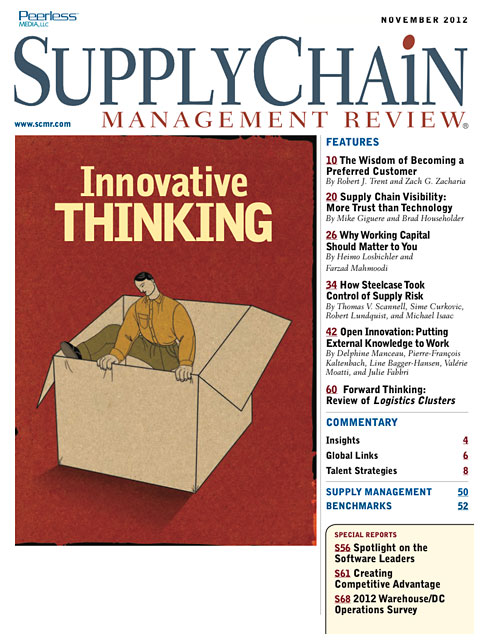Sorry, but your login has failed. Please recheck your login information and resubmit. If your subscription has expired, renew here.
November 2012
We’ve all heard about the advantage of being a preferred customer to your buyers. Now we learn that it’s just as important to become a good customer to your key suppliers. This article explains the benefits of becoming a preferred customer and lays out the actions needed to become one. Browse this issue archive.Need Help? Contact customer service 847-559-7581 More options
If there’s one recurring bad dream that keeps supply chain executives awake at night, it might well be the seemingly impossible quest for better visibility. It’s one of those classic nightmares where you keep grasping for something just out of reach. Even at companies with higher levels of collaboration in their supply chain, it seems that visibility is always “two years off.”
The popular misconception that information technology is the underlying issue limiting data availability—and the resultant visibility—has prompted executives to seek solutions in IT. Given the sizable investments companies have made in IT to harvest supply chain data, the question of why visibility isn’t better is a perplexing one. The “complete” view of inbound supply and outbound fulfillment sustained by seamless upstream and downstream connectivity that managers had been led to expect is proving to be a frustrating, ongoing work in progress. There’s no shortage of technology solutions that purport to enable visibility. Yet getting timely, accurate information with which to run global operations—even after costly IT solutions are in place—remains a daunting challenge.
So if technology is not the bottleneck, then what is? The answer is that the nature of relationships is the primary constraint on what and how much information ultimately gets shared. The more trusting and collaborative the relationship, the more that data is shared and visibility improves; the less trusting and collaborative, the opposite holds true.
 |
This complete article is available to subscribers
only. Click on Log In Now at the top of this article for full access. Or, Start your PLUS+ subscription for instant access. |
Not ready to subscribe, but need this article?
Buy the complete article now. Only $20.00. Instant PDF Download.
Access the complete issue of Supply Chain Management Review magazine featuring
this article including every word, chart and table exactly as it appeared in the magazine.
SC
MR
Sorry, but your login has failed. Please recheck your login information and resubmit. If your subscription has expired, renew here.
November 2012
We’ve all heard about the advantage of being a preferred customer to your buyers. Now we learn that it’s just as important to become a good customer to your key suppliers. This article explains the benefits of… Browse this issue archive. Access your online digital edition. Download a PDF file of the November 2012 issue.
 |
Download Article PDF |
If there’s one recurring bad dream that keeps supply chain executives awake at night, it might well be the seemingly impossible quest for better visibility. It’s one of those classic nightmares where you keep grasping for something just out of reach. Even at companies with higher levels of collaboration in their supply chain, it seems that visibility is always “two years off.”
The popular misconception that information technology is the underlying issue limiting data availability—and the resultant visibility—has prompted executives to seek solutions in IT. Given the sizable investments companies have made in IT to harvest supply chain data, the question of why visibility isn’t better is a perplexing one. The “complete” view of inbound supply and outbound fulfillment sustained by seamless upstream and downstream connectivity that managers had been led to expect is proving to be a frustrating, ongoing work in progress. There’s no shortage of technology solutions that purport to enable visibility. Yet getting timely, accurate information with which to run global operations—even after costly IT solutions are in place—remains a daunting challenge.
So if technology is not the bottleneck, then what is? The answer is that the nature of relationships is the primary constraint on what and how much information ultimately gets shared. The more trusting and collaborative the relationship, the more that data is shared and visibility improves; the less trusting and collaborative, the opposite holds true.
 |
SUBSCRIBERS: Click here to download PDF of the full article. |
SC
MR

Latest Supply Chain News
- April manufacturing output slides after growing in March
- Q1 sees a solid finish with positive U.S.-bound import growth, notes S&P Global Market Intelligence
- World Trade Centers offers a helping hand to create resilient, interconnected supply chains
- 6 Questions With … Sandeep Bhide
- MIT CTL offering humanitarian logistics course
- More News
Latest Podcast

 Explore
Explore
Topics
Latest Supply Chain News
- April manufacturing output slides after growing in March
- Q1 sees a solid finish with positive U.S.-bound import growth, notes S&P Global Market Intelligence
- World Trade Centers offers a helping hand to create resilient, interconnected supply chains
- 6 Questions With … Sandeep Bhide
- MIT CTL offering humanitarian logistics course
- Bridging the ESG gap in supply chain management: From ambition to action
- More latest news
Latest Resources

Subscribe

Supply Chain Management Review delivers the best industry content.

Editors’ Picks





